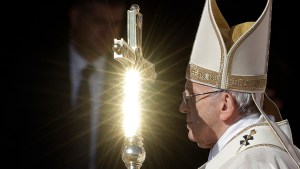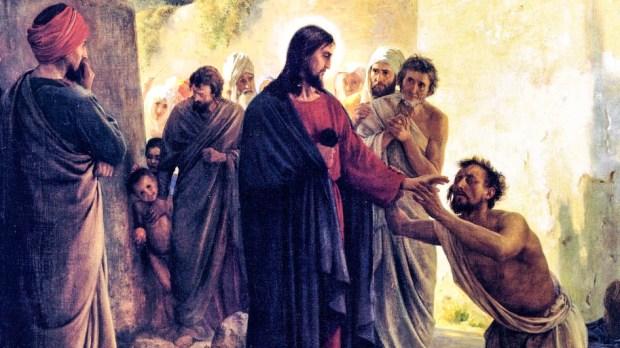They called the blind man, saying to him, “Take courage; get up, Jesus is calling you.” He threw aside his cloak, sprang up, and came to Jesus. Jesus said to him in reply, “What do you want me to do for you?” The blind man replied to him, “Master, I want to see.” Jesus told him, “Go your way; your faith has saved you.” Immediately he received his sight and followed him on the way. —Mark 10:49-52
When I moved to Los Angeles a few years ago, one of the realities I had to adjust to was the large number of homeless people found in nearly every part of this sprawling city. And now, as a resident of Tucson, I still sometimes find myself embarrassed and disconcerted by the extended hands or incoherent mumbling. This is a challenging reality, especially when I remember that as Christians—and especially in my vocation as a religious brother—we’re called to be people of encounter.
With this in mind, it’s easy to imagine the discomfort that Jesus’ followers seemed to have felt in this Sunday’s passage from the Gospel of Mark. After all, the blind man, Bartimaeus, was causing a spectacle, shouting at Jesus. But even after the people in the crowd told him to be quiet, he kept calling out “all the more, ‘Son of David, have pity on me.’”

Read more:
How can I see Christ in him if I won’t even look at him? Discerning my obligation to the poor
To really get a sense of the importance of this story—which is much more than just another account of one of Jesus’ miracles—we have to think about where it falls in the Gospel of Mark. The healing of the blind Bartimaeus is, in fact, linked to the healing of another blind man, recounted only a few chapters earlier (8:22-26).
These two stories form “bookends” for one of the most important sections of Mark’s Gospel in which Jesus tries to help his followers understand who he is and what his mission really is. But, as we’ve discovered over the past several Sundays, the Apostles and the other disciples don’t seem to be able to comprehend Jesus’ message or to understand the true cost and meaning of discipleship. After all, these are the same men who openly opposed him when Jesus tried to teach them about his coming suffering and death.
But then, this Sunday we are given the story of this blind beggar who seems to be able to see what the Apostles cannot. In fact, the physical healing of Bartimaeus is a powerful reminder that, when we open ourselves to God’s grace, we can be healed of that blindness of spirit that sometimes prevents us from following Jesus with freedom and joy, which is an important part of discipleship.
St. Mark beautifully describes Bartimaeus’ excitement when Jesus finally calls for him: “He threw aside his cloak, sprang up, and came to Jesus.” There is an energy in his response that wonderfully exemplifies the enthusiasm that should be a hallmark of our discipleship. When the Lord calls, we must be ready to respond. And because of his faith and willingness to act, Jesus rewards the blind man by not only restoring his physical sight but by empowering him to live out his faith in the community of disciples.

Read more:
Pope gives 2 steps to really knowing Jesus
The invitation for us this Sunday is to humbly reflect on the ways we might be spiritually blind by asking ourselves what habits, attitudes, and ideologies hold us back from becoming the disciples that Jesus is calling us to be.
How do you respond to Jesus’ question, “What do you want me to do for you?”Reflect on times in your life when your spiritual blindness might have prevented you from recognizing the presence of Christ.What is Jesus calling you to do for others?
Words of Wisdom: “Bartimaeus represents one who has lost the light and knows it, but has not lost hope: he knows how to seize the opportunity to encounter Jesus and he entrusts himself to him for healing. Indeed, when he hears that the Master is passing along the road, he cries out: ‘Jesus, Son of David, have mercy on me!,’ and he repeats it even louder. And when Jesus calls him and asks what he wants from him, he replies: ‘Master, let me receive my sight!’ Bartimaeus represents one aware of his pain and crying out to the Lord, confident of being healed … In the encounter with Christ, lived with faith, Bartimaeus regains the light he had lost, and with it the fullness of his dignity: he gets back onto his feet and resumes the journey, which from that moment has a guide, Jesus, and a path, the same that Jesus is travelling. The evangelist tells us nothing more about Bartimaeus, but in him he shows us what discipleship is: following Jesus ‘along the way,’ in the light of faith.”—Pope Benedict XVI

